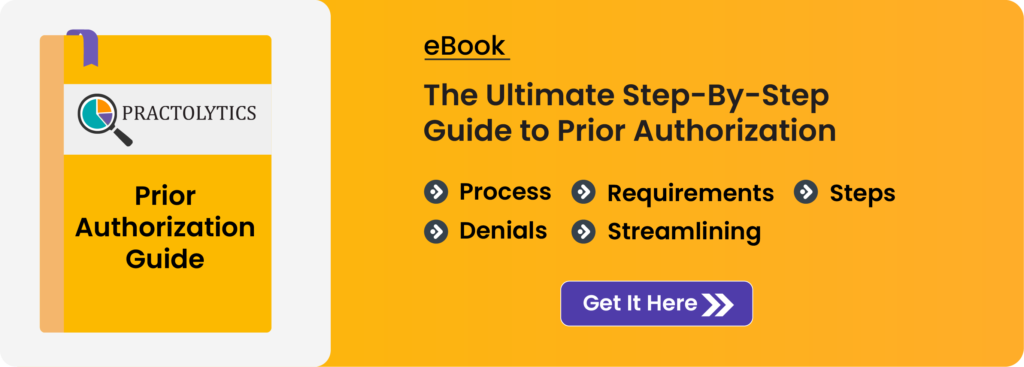How to Track and Report on Your Prior Authorization Success Rate
Tracking your prior authorization success rate doesn’t have to be a headache. At Practolytics, we make it easy to see exactly how to track and report on your prior authorization success rate in your practice. Our dashboards help you spot what’s working, what’s slowing you down, and where denials happen most. From creating a prior authorization denial rate dashboard to tracking turnaround times and workflow metrics, we give you tools that actually make sense. Whether it’s monitoring key metrics in prior authorization management or applying best practices for tracking prior authorization approvals, we keep it simple, practical, and totally actionable!
Let’s be real — chasing insurance approvals can feel like a full-time job. But here’s the thing: if you’re not keeping an eye on your prior authorization success rate, you’re missing opportunities to speed things up, reduce denials, and save everyone a ton of headaches.
At Practolytics, we make prior authorization analytics for medical practices easy to understand and even easier to act on. By focusing on how to measure prior authorization approval rate, your team can see where things get stuck, fix them fast, and actually get back to what matters most — patient care.
Think of it this way: every delayed approval isn’t just a number — it’s a patient waiting, a staff member stressed, and revenue lost. Tracking your success rate changes all that.
Table of Contents
Breaking Down the Core Metrics
Here’s what really matters when it comes to PA success:
- Initial Submission Success Rate – How often you get approved on the first try.
- Final Approval Rate – Total approvals after any appeals.
- Denial Rate – How often requests get turned down.
- Turnaround Time – How long it takes from submission to decision.
Knowing these numbers helps you figure out if the problem is at submission, follow-up, or somewhere else. It’s like having a GPS for your workflow.
Some practices think, “We know our approval rates, isn’t that enough?” Not quite. Without breaking it down, you might see a decent final rate but still waste hours on repeated submissions. This is where reporting prior authorisation performance metrics becomes a lifesaver.
Metrics You Should Definitely Track
Tracking the right metrics for prior authorizations isn’t just a “nice-to-have” — it’s a total game-changer. Without it, approvals can get stuck, denials pile up, and your team ends up buried in paperwork. At Practolytics, we focus on the metrics that really matter so you can spot problems, fix them fast, and keep your workflow smooth.
Check out these top metrics you should be keeping an eye on:
|
Metric |
Why It Matters |
How Practolytics Helps |
|
Initial Submission Success Rate |
Shows how often your submissions get approved on the first try. |
Flags missing docs or coding errors so you can fix them before denials happen. |
|
Final Approval Rate |
Measures total success, including resubmissions and appeals. |
Tracks approvals at every step so you know exactly where things might be slowing down. |
|
Denial Reasons |
Tells you why requests get denied, so you can fix the root cause. |
Tracks approvals at every step so you know exactly where things might be slowing down. |
|
Turnaround Time |
Shows how quickly approvals happen — faster = happier patients. |
Tracks real-time submission-to-decision times so bottlenecks pop right up. |
|
Submission Volume vs Approvals |
Reveals workload balance and team efficiency. |
Helps evenly distribute work and keep your process running smoothly. |
Here’s the scoop: Initial Submission Success Rate is your first checkpoint. If it’s low, it usually means missing info, coding mistakes, or unclear documentation. Practolytics helps flag these before they become denials, saving your team time and headaches.
Next up, Final Approval Rate shows the bigger picture. Even if the first submission fails, this number tells you how effective your follow-ups and appeals are. Tracking it regularly highlights workflow gaps you might otherwise miss.
Denial Reasons are gold. Knowing why requests get denied helps prevent repeat mistakes. Are you seeing missing documentation, coding errors, or payer-specific rules? Practolytics organizes these reasons so you can tackle the biggest issues first.
Turnaround Time is a must-track metric. Quick approvals mean patients get scheduled faster, staff aren’t stressed, and your practice flows better. With real-time tracking, you can spot slowdowns immediately and fix them fast.
Finally, Submission Volume vs Approvals keeps your team balanced. It shows who’s overloaded and where workflows can be adjusted. Practolytics dashboards make it easy to see this at a glance, so nothing slips through the cracks.
By keeping an eye on these five metrics, you’re not just tracking numbers — you’re running a proactive, high-performing Prior Authorization workflow. Using prior authorization KPIs for healthcare revenue cycle, your practice can reduce denials, speed up approvals, and make life easier for both staff and patients.
Where Your Prior Authorization Data Lives
You can’t track what you don’t measure. Here’s where your data comes from:
- EHR / Practice Management System – Your main hub for submissions and updates.
- Insurance Portals – Real-time approvals, denials, and notes.
- Internal Logs – Staff notes, follow-ups, and timestamps.
- Analytics Dashboards – Like Practolytics — it pulls it all together so you don’t have to.
By combining these sources, you get full visibility for prior authorization submission to decision tracking. No more guessing if your numbers are right or missing key denials.
Common Roadblocks and How to Avoid Them
Even the best teams hit snags. Here’s what we see most often:
- Incomplete documentation – Missing codes or unclear notes slow approvals.
- Manual tracking errors – Excel sheets are tempting but messy.
- Delayed payer updates – Makes your metrics look worse than they are.
- No standardized KPIs – If you don’t know what to track, nothing improves.
Tip: Start small. Focus on the top 3 metrics causing the most pain. Once they’re under control, layer in more key metrics in prior authorization management.
Tech and Predictive Analytics: Your Secret Weapon
Here’s where it gets exciting. Automation and predictive analytics don’t just save time — they prevent headaches before they happen.
- Identify cases likely to be denied before submission
- Track approval vs denial trends across payers
- Optimize staff assignments using workflow metrics
- Benchmark performance and spot patterns using historical data
At Practolytics, our dashboards let you view your prior authorization denial rate dashboard, measuring prior authorization turnaround time, and other important metrics in one spot. You’ll know exactly where approvals get stuck, and you can act fast.
Real-Life Scenario: Turning Data Into Action
Let’s say Dr. Sharma notices her MRI procedures have a lower Prior Authorization success rate than Dr. Rao’s. By using prior authorization KPIs for healthcare revenue cycle, she discovers:
- Missing documentation in 25% of submissions
- Turnaround time averaging 5 days longer than peers
- Denials mostly due to outdated ICD coding
With this data, she quickly adjusts workflows, trains staff, and updates templates. Within weeks, the initial submission success rate jumps, denials drop, and her patients get faster appointments.
This is the power of tracking prior authorizations workflow metrics — it turns numbers into real improvements.
Tips for Better Prior Authorization Performance
Here’s some actionable advice:
- Audit regularly – Check 5–10 submissions weekly for errors.
- Standardize templates – Use clear fields for diagnoses and procedures.
- Train staff on denial trends – Knowledge is power.
- Automate reminders – Alerts for follow-ups save hours.
- Use dashboards – Seeing your metrics visually makes trends obvious.
Following these tips helps you consistently improve your prior authorization approval vs denial analysis, keeping workflows smooth and staff happy.
Conclusion:
Tracking your prior authorization success rate isn’t just about numbers — it’s about saving time, reducing frustration, and keeping your patients happy. At Practolytics, we make prior authorization analytics for medical practices simple and actionable. Our dashboards and predictive insights help you spot bottlenecks, fix denials fast, and keep approvals moving. You get real-time visibility, standardized KPIs, and tools that actually help staff work smarter, not harder. With us, your practice can focus less on paperwork and more on patient care — all while improving revenue and workflow at the same time.
At Practolytics, we take the stress out of prior authorization success rate tracking. Our tools pull data from every corner of your workflow, show it in simple dashboards, and help your team act fast. We combine automation, predictive insights, and real-time reporting so your approvals move quicker, denials drop, and you can focus on what really matters — caring for patients. Hundreds of practices trust us to make prior authorizations painless, accurate, and even a little enjoyable.
Why should I, as a physician, care about the administrative Prior Authorization success rate?
Because it impacts your patients, your schedule, and your bottom line. Low success = more denials, more headaches.
What’s the difference between Initial Submission Success Rate and Final Success Rate?
First one is approvals on the first try; final is after appeals. Tracking both shows where your process can improve.
Which Prior Authorization denial code should I focus on most?
Look at the most common codes for your specialty — usually incomplete documentation or coding mistakes.
How does vague documentation hurt my Prior Authorization success?
Missing or unclear info leads to denials, slows turnaround, and wastes staff time.
My procedure has a lower Prior Authorization success rate than a colleague’s. Why?
Could be documentation, payer preferences, or workflow differences. Tracking key metrics in prior authorization management helps spot the problem.
Read More – Prior Authorization Services for Podiatry : improving Patient Access and Care
Talk to Medical Billing Expert Today — Get a Free Demo Now!






